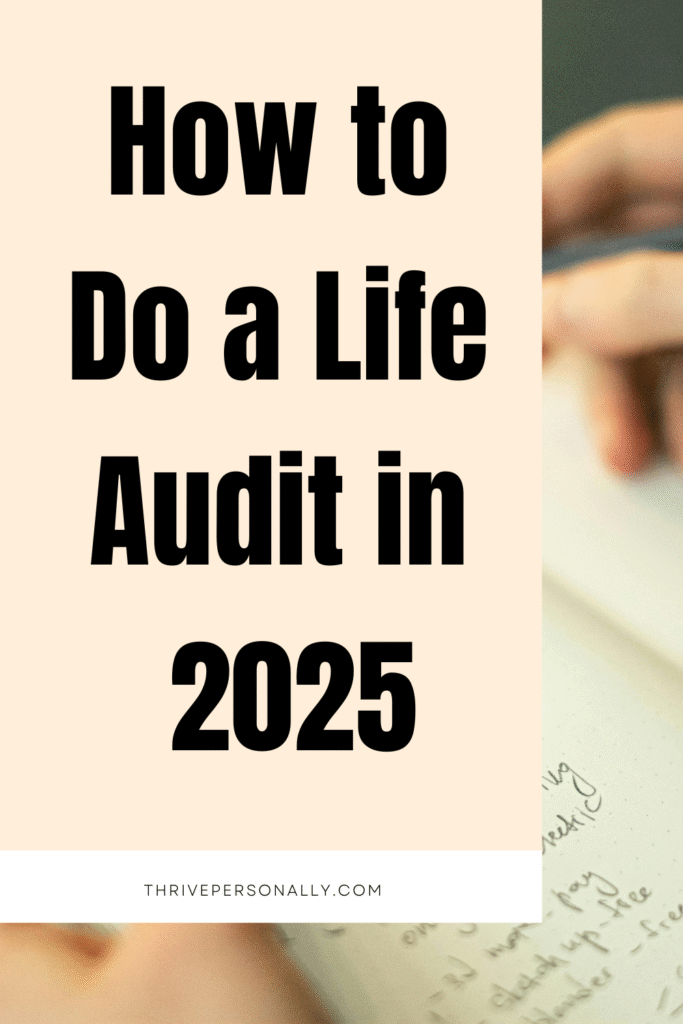The more articulate, gentle version of that notebook moment is what we call a life audit. It’s a careful way to check which areas of your life line up with what truly matters to you, and which areas need some improvement. Performing a life audit in 2025 is more practical than ever because the world is changing at such a rapid pace. New tools, new work patterns, and new rhythms of life make it wise to pause, reflect, and realign.
In this post, I’m going to take you through a full life audit you can do for yourself. The steps will be easy, the language simple, and the ideas practical—so you can begin now and plan out the year ahead with clarity.
Why Do a Life Audit Now?
A life audit helps you stop drifting. It gives you a map so your choices line up with what you truly want. It also helps you notice small habits that quietly drain your energy—like slow leaks you may not see until you feel exhausted.
Life audits are especially useful during times of transition. But they also bring value when life feels “fine” yet you want deeper clarity and direction. According to Real Simple, a life audit helps you take stock in areas like health, relationships, career, finances, and purpose. From there, you can set clear goals and healthy boundaries to prevent burnout.
What You’ll Need
You don’t need fancy tools. All you need is:
-
A notebook or digital document
-
Two to three hours (spread across a few sessions if needed)
-
Honesty with yourself
It can also help to have a calendar, a simple to-do space, or an area to track metrics like sleep, steps, or even how often you say “no.”
And because digital noise is such a drain today, it’s smart to include a short digital declutter in your life audit. This means stepping away from optional apps and online habits to get clearer about what really matters. The practice ties into the idea of digital minimalism by Cal Newport.
Step 1: Create the Right Atmosphere
Be curious, not judgmental. A life audit is not about finding fault but about gathering facts so you can make better choices.
Decide how much time you’ll set aside—one morning, a few sessions across a week, or a slower reflection over a month. Start your audit by writing a short opening sentence like: “I’m doing this to make space for what matters most to me.” Keep it in sight as a reminder when decisions feel uncertain.
Read also: 7 Daily Self-Motivation Habits
Step 2: Break Life Into Categories
Divide your life into clear sections. Common ones include:
-
Relationships
-
Work or career
-
Money
-
Home and environment
-
Learning and growth
-
Rest and play
-
Digital life
-
Health
For each category, answer three simple questions:
-
What’s working?
-
What’s not working?
-
What do I want instead?
Keep it short. Think of it as a snapshot, not a full story.
Read also: Setting Goals: A Guide for Success
Step 3: Look for Patterns and Feelings
Once you’ve answered all sections, read them together. Do you notice trends? Do certain emotions show up often—like worry, fatigue, or excitement?
These patterns matter. They show you where to focus energy and where to set boundaries. If something repeats across more than one area, it’s probably significant and deserves your attention.
Read also: 10 Steps to Work on Yourself for Personal Growth
Step 4: Measure What Matters
Measurement doesn’t have to be complicated. Choose one or two simple numbers for each category to track change. For example:
-
Sleep: track hours of rest
-
Relationships: track meaningful conversations each week
-
Work: track hours spent in focused work vs. busywork
-
Money: track savings or spending
The goal is not to feel busy but to notice meaningful progress.
Step 5: Choose Three Priorities
From your patterns and measures, pick three main priorities for the next 3–6 months. Three is the right number—small enough to manage but big enough to matter.
Write them as short, clear phrases that show the change you want. For example: “Reduce fatigue,” “Strengthen a key relationship,” or “Advance my career growth.”
Step 6: Try Small Experiments
Instead of making huge plans, design small experiments. These are short, low-stakes behaviors that last two to four weeks. Each experiment should have:
-
A clear start date
-
A clear way to measure success
Experiments are not about proving success or failure but about gathering information. They keep you from burning out or staying stuck in unhelpful routines.
Step 7: Build Habits to Support Priorities
Habits are what turn small experiments into lasting change. The rules are simple: start small, celebrate wins, and connect new habits to things you already do.
As James Clear explains, lasting habits grow from small, repeatable actions and environments that support good behavior while discouraging bad ones.
Step 8: Do a Digital Audit
So much of life now runs through digital spaces, which can add overwhelming noise. A digital audit helps you see which tools support your goals and which waste your energy.
One method is to take a 30-day break from optional digital tools. Afterward, reintroduce only those that truly help your priorities. This “restricted use” practice, also described by Cal Newport in Digital Minimalism, strengthens focus, sleep, and peace of mind.
Step 9: Set Clear Goals
Use SMART goals (Specific, Measurable, Achievable, Relevant, Time-bound). For each priority, make it a SMART goal and break it down into three small, doable actions for the week ahead.
Keep the steps simple enough to follow through.
Step 10: Create Boundaries and Routines
Boundaries protect your time and energy. Routines give your days structure. Both are needed for lasting change.
Look for places to set boundaries—like turning off notifications at night or saying “no” to draining requests. Then shape morning and evening routines that are short, easy, and repeatable.
Step 11: Check In Regularly
A life audit isn’t a one-time task. The best results come from regular check-ins.
Try this rhythm:
-
15–30 minutes weekly for small reviews
-
1 hour monthly for bigger patterns
-
2–3 hours quarterly for deeper shifts
-
A full life audit once a year
According to Real Simple, regular check-ins keep your plan alive, prevent stagnation, and make burnout less likely.
Final Thoughts
The best life audits are kind. They don’t shame you for where you are but help you see clearly and decide wisely.
A life audit in 2025 is simply a way to make sure your life aligns with what matters most today. The world will keep changing, but this practice gives you a stable map to guide your next steps.
Here’s a simple way to start: choose three priorities and design one small experiment for each over the next four weeks. Keep them small enough to succeed and to learn. Then, revisit your notes a month later, as if you were reading them for a friend you truly care about.
One gentle change at a time can lead to remarkable growth
Save the pin for later



